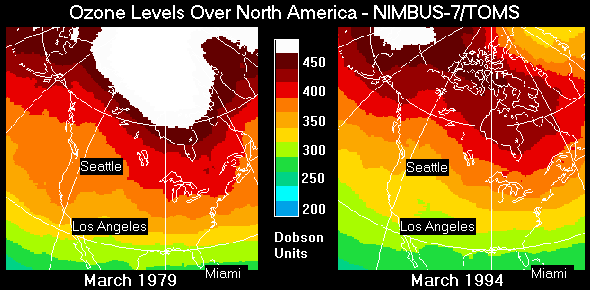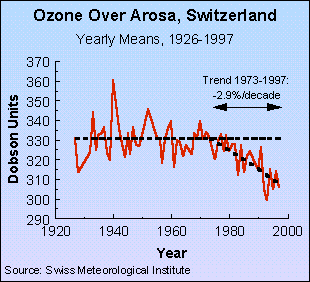Stratospheric ozone and skin cancer
|
E. Linacre |
2/’02 |
|
Stratospheric ozone at middle latitudes shows a seasonal variation of about ±20%, a quasi-biennial oscillation of 1-10%, and a long-term variation as follows: the level was almost steady until about 1979 but declined thereafter by about 10%, and the decline continues (Fig 1). A springtime ozone hole of the magnitude detected over Antarctica does not exist over the Arctic, but in the mid-latitudes of both hemispheres, the decline has been largest in springtime (Fig 2). The observed decline implies about 10-20% more UV-B. This would explain a 20-40% rise in skin cancer in the human population since the 1970's. The incidence of skin cancer has risen by much more, by about 90% in USA during 1974-1990 (1). This is due primarily to increased exposure to the sun, but also to a growing population of elderly people and better health screening. |
Fig 1: Ozone column depth over Arosa, Switzerland, from 1928 to 1996. |

Fig 2: Satellite-based estimate of ozone column depth in (a) March '79, and (b) March '94. (Source: NASA Goddard Space Flight Center)
Skin cancer does not develop immediately
after exposure to solar UV-B but takes decades, so recent skin cancer must be
due to exposure in the 1950s to the 1970s. This was a period when there was no
ozone depletion, yet sunbathing slowly became a popular pursuit and protective
sunscreen lotions hardly existed. Further significant increases in skin cancer
can be expected during the next few decades, as the sun-loving post-war
baby-boom (1945-'65) ages.
Excessive exposure to UV-B has other
health effects, such as cataracts and a decline of the immune response system.
Reference
(1) Kane, R.P. 1998. Ozone depletion, related UVB changes and increased skin cancer incidence. Internat. J. Climatology 18, 457- 472.
